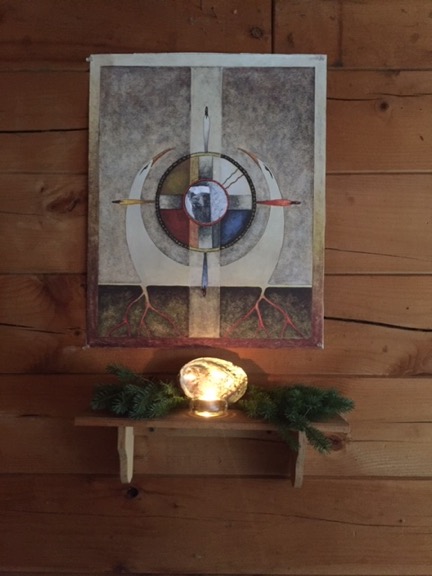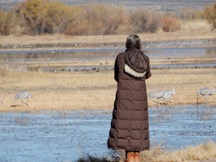Issue #12 - “HOW DO WE KNOW?” Part II
Issue #12, March 2021
TABLE OF CONTENTS
Lise Weil, Kristin Flyntz, Deena Metzger, Andrea Mathieson, Margo Berdeshevsky, Sara Wright,Melissa Kwasny
Editorial Conversation
Deena Metzger
The Imagination is a Real Place: from La Vieja: A Journal of Fire
Margo Berdeshevsky
Half Notes
Sara Wright
Crane Song: Finding my Way Home
Melissa Kwasny
Embodied Knowing: Poetry by Sarah Gridley, Tami Haaland, Lois Red Elk, Adrie Rose, Susan Terrence and D. Walsh Gilbert
Andrea Mathieson
What We Know in Our Bones
Anne Bergeron
After•Word: Jane Caputi’s Call Your Mutha: A Deliberately Dirty-Minded Manifesto for the Earth Mother in the Anthropocene
Lise Weil
After•Word: Tanya Tagaq’s Split Tooth
Sara Wright
Crane Song: Finding My Way Home
Ways of knowing may be passed on in non-linear ways—circular ways—that are not acknowledged by Western culture. What follows is one woman’s story of finding her way home—back to her Native roots—through the power of an image of the Medicine Wheel, with assistance from a dead Abenaki Medicine woman, the sharing of Indigenous story, celebrating ritual, and moving through time. There is no progression here, just a circular journey with new insights occurring with each turning of the wheel.
The last gift I received from my very distant parents was a print of a Native American Medicine Wheel by Ojibwa artist Joe Geshick. I received this present on my birthday in 1993.
When I opened the cardboard tube I was astonished by the image. A Medicine Wheel? As far as I knew neither of my parents had any idea that I had picked up the thread of my Native heritage and was studying Indigenous mythology. What could have motivated them to send me such a thing? I was stunned by the seemingly bizarre synchronicity.

At the time I was also giving an Indian program in the local elementary school called “The Circle Way,” educating children and myself about the mysteries of the medicine wheel.
An Abenaki Medicine woman, a healer named Mollyockett who lived in the area during the 19th century, seemed to be guiding me in this process. Before walking to school to give my program I stopped at her gravesite to ask for help. One day I was shocked to discover a Great Blue heron sitting on her gravestone. Some days I could feel a presence when I knelt there in the tall grass.
Thanks to interlibrary loan, I was also learning about my own Passamquoddy/Malisset heritage, but I felt like I knew almost nothing about Northern tribes in general; most had been decimated by disease brought to them by the colonists that destroyed Native core values and the way of life for most of these Indigenous peoples. Some pockets of Native peoples, beliefs, and stories survived in Canada because they had less contact with white people.
I hung up the Medicine Wheel immediately and began to use it as an image to help me prepare for my classes. The wheel reflected equality on a level that was familiar to me; we were all connected—trees, people, rivers, flowers. As a dedicated naturalist/ecologist I had always felt this idea to be truth, but suddenly I began to speak about what I knew with a voice I didn’t know I had.
When my father died suddenly about six weeks later the Medicine wheel (otherwise known as “The Circle of Life”) became the last gift I ever received from either of my parents; it developed a ‘charge’ that resulted in me hanging the wheel in every space I ever inhabited. It is still with me.
In 2013 I was finishing a thesis on my study of Black Bears and decided this image would become the cover of my manuscript. Researching the artist, I learned that Joe was born in 1943, grew up on a reservation in Northern Minnesota, spent two years in jail for minor infractions and began to paint there. After his release he studied at the Art Students’ league in NY and then taught art in Ontario. On the La Croix Reservation in Ontario he learned something about the fragmented history of his clan, and was introduced to traditional ceremony. In 1977 he began studying with a Lakota Sioux Medicine Elder in Nevada while participating for five years in the annual Sundance Ceremony.
As a result, Joe became rooted in traditional ceremony and his paintings reflect this dramatic spiritual shift. “The Circle Of life” embodies this change, drawing attention to the four sacred directions, the four seasons, the sacred colors, the four races. All are equal; all require respect. Joe often said that he wanted people to relate to his work through personal experience.
After doing preliminary research on the artist, I recognized, that like him, I too had been totally separated from my Native roots and was finding my way back through image, my experiences with animals/plants, creating/celebrating my own ceremony, and by studying Native mythologies. A slow, circular lifetime process. But Joe became a model for me, validating that the way that had been chosen for/by me was an authentic one.
I felt a deep kinship with this particular wheel with one exception. In the center Joe had placed a thunderbird; after learning about the Ojibwa I didn’t understand why the bear wasn’t in the center of the wheel because the bear was the most venerated healer for his people.
Recently, I returned from the Southwest where I was introduced to the ceremonies of the Pueblo peoples, ceremonies that reflected my own spiritual practices, reinforcing their authenticity. This interlude also allowed me to be part of a people who had never lost access to their roots. They had never given up their ceremonies or surrendered their way of life.
I returned to Maine with a much stronger sense of my Indigenous cultural identity than I had when I left. I hadn’t realized until I went to the Southwest how much this identity had been eroded by local people. Living in western Maine had brought me in contact with the frightening bias people have towards Indians; some are openly despised.
My first reality ‘hit’ occurred a few months after moving to the area after giving an elementary school program when fifty people from an irate religious group gathered one night at the school and attempted to indict me as a witch. “I was turning their children into trees,” one of my accusers said. Although the program I had given was an astounding success, no one intervened on my behalf, including the superintendent of schools and the principal of the school who asked me to give the program in the first place.
Numerous other negative encounters followed over the years. Two neighbors bought property next to me and moved in. I didn’t understand why they disliked me. It took me years to understand the reason. Because I am “different”—an “Indian” (their words, not mine).
Just up the road from my home seven years ago some locals put up signs that stated “We don’t trust you, Sara Wright,” for exactly the same reason, in an effort to humiliate me and prevent me from walking up a mountain road.
I was betrayed by the town of Bethel when I offered to become part of their annual Mollyockett Day—supposedly a celebration of Mollyockett and our Maine Abenaki Native heritage. In actuality this celebration had/has nothing to do with Native peoples. One of their most egregious practices is the frog-jumping contest when hapless amphibians are forced to hop around steaming concrete for children’s pleasure. No Native person would ever agree to torturing animals in that way.
Just last spring, two months after my return from New Mexico, a red truck left a dead baby grouse in my driveway. Others continue to leave screaming tire marks. I am an “outsider” because of my heritage, regarded with suspicion. These grim examples reveal that hatred of the ‘other’ and discrimination is a way of life here.
But to return to my present story… this fall I decided to do something different with my medicine wheel. I carefully cut out a photo of one of my bears sitting in the mother pine and placed the photo in the center of the wheel, replacing the thunderbird. Ah, now the wheel looked just right, and I placed the print above a little mantle in a dark corner of the living room. A solitary candle lights the wheel unless the sun is just right and then the entire space lights up eerily. An abalone shell reflects the blue green waters below.
With the Medicine Wheel in a place of honor I decided to do some more research on the image. I was astonished to learn that the ‘swans’ that encircled the wheel were cranes – Sand hill Cranes, my spirit bird of the East—birds whose haunting cries literally freeze me in wonder—birds that I lived with every winter in NM for four years, birds that I discovered to my great joy are now living/breeding here in western Maine. Cranes, not swans. And Joe painted the cranes with their feet becoming red roots seeking green earth ground. According to Joe, “the two cranes that envelop the circle represent a spiritual relationship with the earth.” Exactly! Oh, it fit.
Sand hill Cranes, my spirit bird of the East—birds whose haunting cries literally freeze me in wonder—birds that I lived with every winter in NM for four years, birds that I discovered to my great joy are now living/breeding here in western Maine. Cranes, not swans. And Joe painted the cranes with their feet becoming red roots seeking green earth ground. According to Joe, “the two cranes that envelop the circle represent a spiritual relationship with the earth.” Exactly! Oh, it fit.
Then came the next surprise. I read that in their creation story the Ojibwa who were water people were led by the Sand hill Cranes who were their leaders. The original holy people were cranes, loons, fish, deer, marten, bear and thunderbird but the thunderbird had to be returned to the sea because his powers were too strong. The Bird people replaced the thunderbird. Today the Crane clan is the leader followed by the Bear, as Healer.
I guessed that it was Joe’s spiritual experience with the Lakota Sioux that led him to place the thunderbird in the center of his medicine wheel paintings because the thunderbird is sacred to the Lakota Sioux.
Joe died in 2009 but what follows is what he wrote about his beautiful and deeply moving paintings.
I am motivated to paint by my desire to share this connection with others so that they may discover their own natural and spiritual relationship with the earth. I want people to feel and experience the wholeness and simplicity of life.
Today, our blue green planet is in crisis and I believe our only real hope comes from embracing the ways of a people we despise or dismiss, a people whose way of life could teach the rest of us how to embrace “The Circle Way”—the values of respect, equality, community, a gift economy—and most of all help to reattach us to this Earth we call home.
About the Author

Sara Wright is a dedicated eco – feminist, naturalist, ethologist, and writer. She lives in a little log cabin in the western mountains of Maine with two small dogs and one dove. Sara writes weekly columns that appear in The Bethel Citizen and The Abiquiu News. Sara has Native American roots, which may or may not be why she has dedicated her life to speaking out on behalf of the slaughtered trees, dying plants and disappearing animals. Please visit her blog “Over the Edge and Beyond: Journal of a Naturalist.” http://sarawrightnature.wordpress.com
To comment on this article, please click here.
Copyright © 2014-2021 Dark Matter: Women Witnessing - All rights reserved to individual authors and artists.
Email: Editor@DarkMatterWomenWitnessing.com
Please report any problems with this site to webmaven@DarkMatterWomenWitnessing.com
